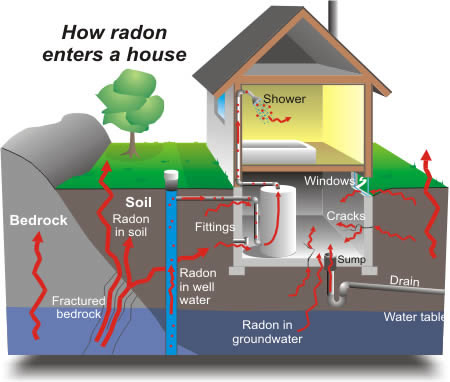What is Radon Gas
Radon is a radioactive gas - this means that it continuously decays and releases radiation. It is produced from minerals in the soil, such as uranium and radium.
Breathing in radon is the second largest cause of lung cancer in the UK resulting in up to 2000 fatal cancers per year. However, radon hazards are simple and cheap to measure and relatively easy to address if levels are high. Under UK regulations all employers must review the potential radon hazard in their premises.
Read more about the impact of Radon Gas at www.hse.gov.uk
Although radon is present throughout the environment when high levels are present indoors people are exposed to more of its radiation and their risk of cancer increases. Such a situation can be discovered easily and corrected.

How does radon enter a home or workplace?
Radon, because it is a gas, is able to move though spaces in the soil or fill material around a home or workplace's foundation. Most buildings tend to operate under a negative pressure - this is especially true in the lowest portions of the building and during the heating season. This negative pressure acts as a vacuum (suction) that pulls soil gases, including radon, into the lower level of the structure.
Some causes of negative vacuum are:
- Heated air rising inside the building (stack effect).
- Wind blowing past a building (downwind draft effect).
- Air used by fireplaces, wood stoves, and furnaces (vacuum effect)
- Air vented to the outside by clothes dryers and exhaust fans in bathrooms, kitchens, or attics (vacuum effect).
- Radon can enter a building through the floor and walls -- anywhere there is an opening between the building and the soil.
- A basement, of course, provides a large surface area that contacts soil material.
- Major Radon Entry Routes
- Cracks in concrete slabs.
- Spaces behind brick veneer walls that rest on uncapped hollow-block foundations.
- Pores and cracks in concrete blocks.
- Floor-wall joints.
- Exposed soil, as in a sump or crawl space.
- Weeping (drain) tile, if drained to an open sump.
- Mortar joints.
- Loose fitting pipe penetrations.
- Open tops of block walls.
- Building materials, such as brick, concrete, rock.
- Well water (not commonly a major source in Welsh homes).
What happens after radon gets into a building?
Once radon enters a building it moves freely throughout the air indoors, where people can breathe it into their lungs. Understanding how it distributes through the environment can help explain why timing and location are important factors to consider when conducting a radon test.
The level of radon is often highest in the lower part of the building. Radon moves by diffusion and natural air movements, so it can be distributed by mechanical equipment such as a forced-air ventilation system. As radon moves away from a building's foundation or other entry points, it mixes (and is diluted) into a greater volume of air. Additionally, more dilution often occurs in the upper levels of the building because there is more fresh air ventilation.
Greater dilution and less vacuum may also occur when the house is more open to the outdoors during the non-heating season. This generally results in lower indoor radon levels in the summer compared to the winter.
How can I find out if my home or workplace has a radon problem?
Radon is colourless, odorless and tasteless. Therefore, a radon test is the only way to find out how much radon is in your home. RPW Radon Wales recommends that all employers and homeowners have their properties tested for radon gas. Every building is unique due to its local soil, construction details, maintenance and degree of depressurisation. Therefore, test results from nearby buildings cannot be relied upon to predict the radon level in another. Likewise, previous test results may not reflect current and future radon levels for a building that has been remodeled, weathered or had changes made to its heating, air conditioning or other ventilation and heating systems.
The results of a properly and professionally performed radon test will help employers and homeowners determine for themselves if they need to take further action to protect their employees or family from the health risks of radon.
Contact RPW Radon Wales by telephoning 01994 231 850
Radon Council Wales
Tel: 01994 231 850